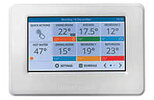The attachments when clicked on come up with "Opps! We ran into some problems" so only thing what has changed is you say it is S plan.
First the central heating, I am an electrician not a heating engineer, but basic way gas (not oil) central heating works, is hot water is pumped around the system, through thermostatic radiator valves (TRV) on every radiator, and as these close the by-pass valve opens allowing hot water to return to the water heater, which then modulates (turns down output) to match the demand, until it can't turn down any more, then it starts a mark/space ratio, turning boiler off/on slowly increasing the off time.
The problem is, it would never turn fully off, you could do that manually, but better if automated, best is for the TRV heads to be linked to the controller, so when all satisfied boiler is turned off. However that tends to be expensive, so we are told to select a ground floor room, as heat raises, normally kept cool, as we want heating to turn off as ambient temperature raises, with no outside doors, or alternative heating, and not fit a TRV in that room, but use a wall thermostat. And use the lock shield valve on the radiator to adjust heating speed so that room is slowest to heat up.
Don't know your house, but my house no such room, front and back doors, and three patio doors, so six doors to enter and exit house, a open fire in one living room and two kitchens with cookers and washing machines etc, so looking at near enough engineering.
So that means balance a wall thermostat and TRV, so mother house (this one oil so different) in the hall both a wall thermostat and TRV on the radiator the radiator closer to front door, and TRV lower down, so TRV set to around 17ºC and wall thermostat to 19ºC so the scenario was, front door opened, hall cooled, and TRV turns on, the hall heats say 10ºC to approx 16ºC and the TRV starts to close, but they are analogue, so closes over say 4ºC so in heart of winter the wall thermostat never turns off, and whole house controlled by the TRV's, but as summer approaches, then the hall does get warm enough to turn off the wall thermostat so boiler turns off.
One can improve on the basic system by using programmable TRV heads and programmable wall thermostat, even put in two wall thermostats to allow for change in wind direction, but we are work with near enough engineering it will never be perfect. I got eQ-3 programmable TRV heads for £15 each in 2019, the terrier i30 very similar, they do not link to any hub or thermostat.
As one pays more, you can have them linked to a hub

so you can control each TRV from a central hub, there are many systems, but TRV heads get more expensive some are around £80 per head, you need to strike a balance. No right, wrong, or best, they all work, but cost to run central heating changes, and remember the boiler is analogue so analogue controls are best, on/off wall thermostats can make it worse not better, main control is with TRV's.
Now onto domestic hot water, if stored needs to be over 60ºC to stop legionnaires. 65ºC is normal, in winter warming up pipe work does not matter, as that heat will go into the house, summer however different story. Gas is cheaper than electric, but you have more losses with gas, so all down to how much DHW is used. My wife and I use an instant electric shower, so DHW is only for washing hands, and the odd dish which can't go into the dish washer, we have no thermostat on the DHW tank except for the immersion heater, so only control was time, our Nest Gen 3 allows us to set how long what time and what day of week heated in half hour increments, so set 4 times a week ½ hour at a time, but after 20 minutes return water too hot so boiler would turn off, so 20 kW boiler, oil so always at 20 kW when running so 80 hours per week = approx 25 kWh to heat domestic hot water, when solar fitted started using the immersion heater with an iboost+ which uses excess solar, and logs how much used per week, approx 2.5 kWh, oil and gas are cheaper, but not a tenth of the price of electric, so for us, using electric is cheaper in summer, winter no option, if central heating running DHW is heated, no way to turn it off.
This is a three story house, so long pipe run, not lagged boiler to cylinder, if the two were closer it would change how much lost, but you want a boiler to fire up the least times it can and keep water hot, so with a boiler timed DWH is good, but with immersion there is no looses from pipework or boiler, so no real need to set times, unless you have an off peak supply, just leave it on.







